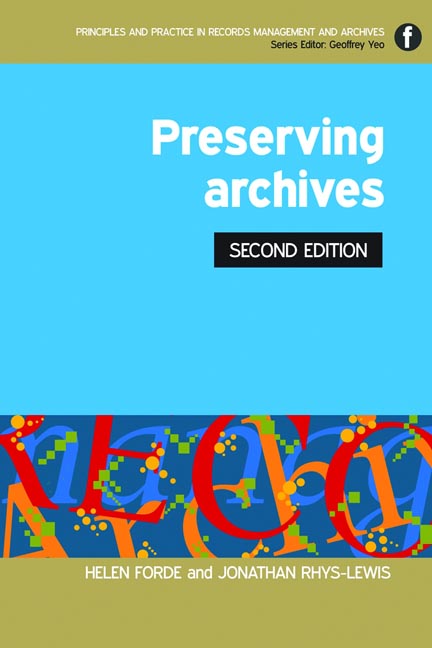Book contents
- Frontmatter
- Contents
- Introduction to the series Geoffrey Yeo
- Preface to the Second Edition
- Acknowledgements
- 1 Introducing archive preservation
- 2 Understanding archival materials and their characteristics
- 3 Managing digital preservation
- 4 Archive buildings and their characteristics
- 5 Safeguarding the building and its contents
- 6 Managing archival storage
- 7 Managing risks and avoiding disaster
- 8 Creating and using surrogates
- 9 Moving the records
- 10 Exhibiting archives
- 11 Handling the records
- 12 Managing a pest control programme
- 13 Training and the use of volunteers
- 14 Putting preservation into practice
- Appendices
- Bibliography
- British and international standards relating to archive preservation
- Index
5 - Safeguarding the building and its contents
Published online by Cambridge University Press: 09 June 2018
- Frontmatter
- Contents
- Introduction to the series Geoffrey Yeo
- Preface to the Second Edition
- Acknowledgements
- 1 Introducing archive preservation
- 2 Understanding archival materials and their characteristics
- 3 Managing digital preservation
- 4 Archive buildings and their characteristics
- 5 Safeguarding the building and its contents
- 6 Managing archival storage
- 7 Managing risks and avoiding disaster
- 8 Creating and using surrogates
- 9 Moving the records
- 10 Exhibiting archives
- 11 Handling the records
- 12 Managing a pest control programme
- 13 Training and the use of volunteers
- 14 Putting preservation into practice
- Appendices
- Bibliography
- British and international standards relating to archive preservation
- Index
Summary
Introduction
All archives need to install certain safeguards against threats, both to the records themselves and to the people working in the building, both public and staff. This chapter looks at the main threats and ways of mitigating them; they include:
• security provision
• fire prevention, detection and suppression
• water detection.
Security
Security is ‘the very essence of a repository’ (Kitching, 1993, 33) and must be taken very seriously. Breaches of security are potential threats to the validity of the documents stored in an archive, since loss of custody could jeopardize authenticity. But physical security installations are not enough. They must go hand in hand with good security procedures to ensure the maximum protection possible, always bearing in mind the need for access to the building by the public. A balance must be struck between fortress-like security and permitting rights of access to information. Not all security precautions need apply to the whole building and where archives form only a section of a building this must be recognized. Selecting the appropriate level of security for each part is important, as overprovision results in irritation and delay, as well as possible reliance on installations where better or tighter procedures might provide a preferable solution. To ensure that the measures are appropriate a risk assessment must be carried out; no two archives will face exactly the same problems. A major issue, common to all archives, libraries and museums, is that staff are a greater risk to the organization and its holdings than members of the public. This is an uncomfortable truth, but one which must be taken into account when considering appropriate security measures and procedures.
Questions for security risk assessment
The following questions might form the basis for a risk assessment but will be supplemented by others relating to particular circumstances.
• Are any roof lights or basement openings planned?
• What kind of external lighting/security lighting is planned?
• What kind of planting is planned round the building?
• Will internal CCTV be installed?
• Will intruder alarms be installed?
- Type
- Chapter
- Information
- Preserving Archives , pp. 59 - 70Publisher: FacetPrint publication year: 2013



